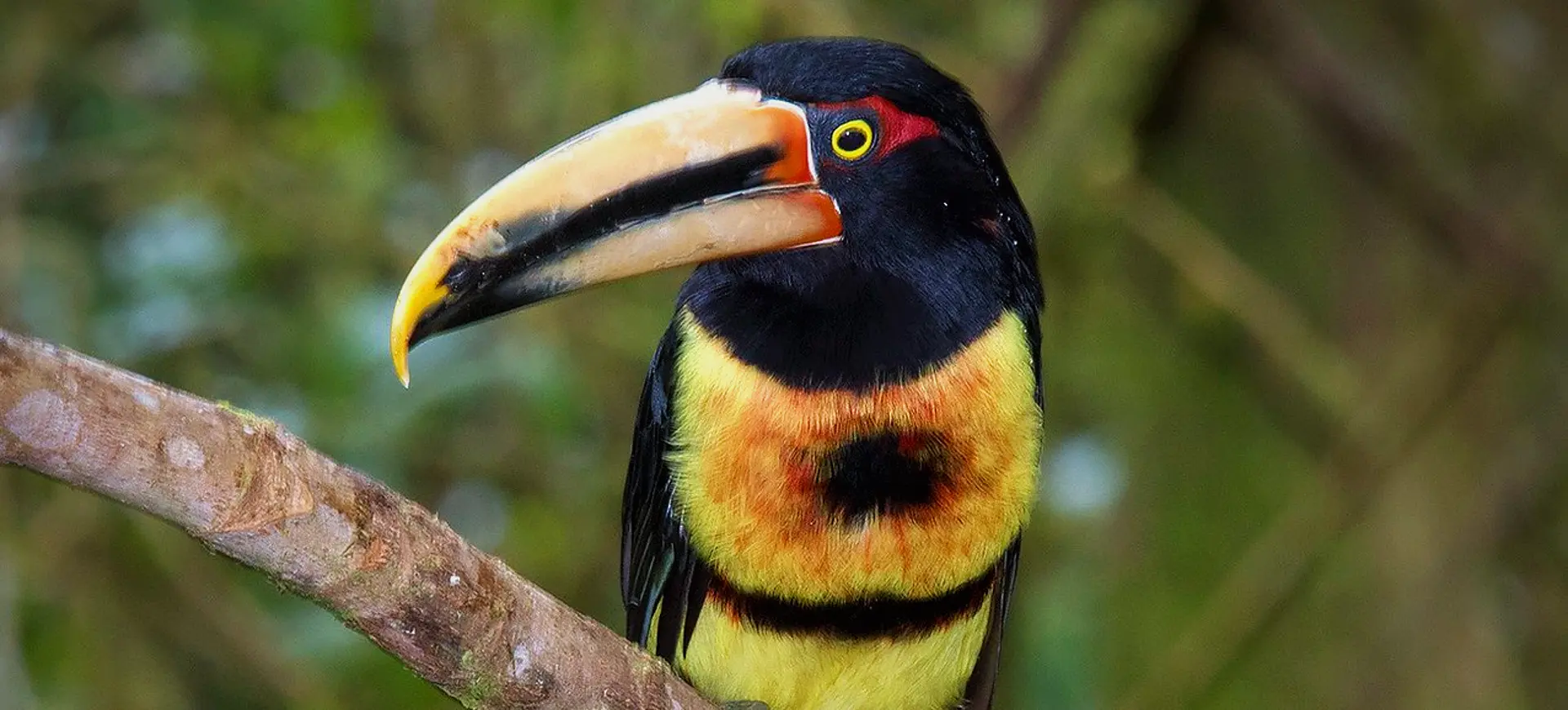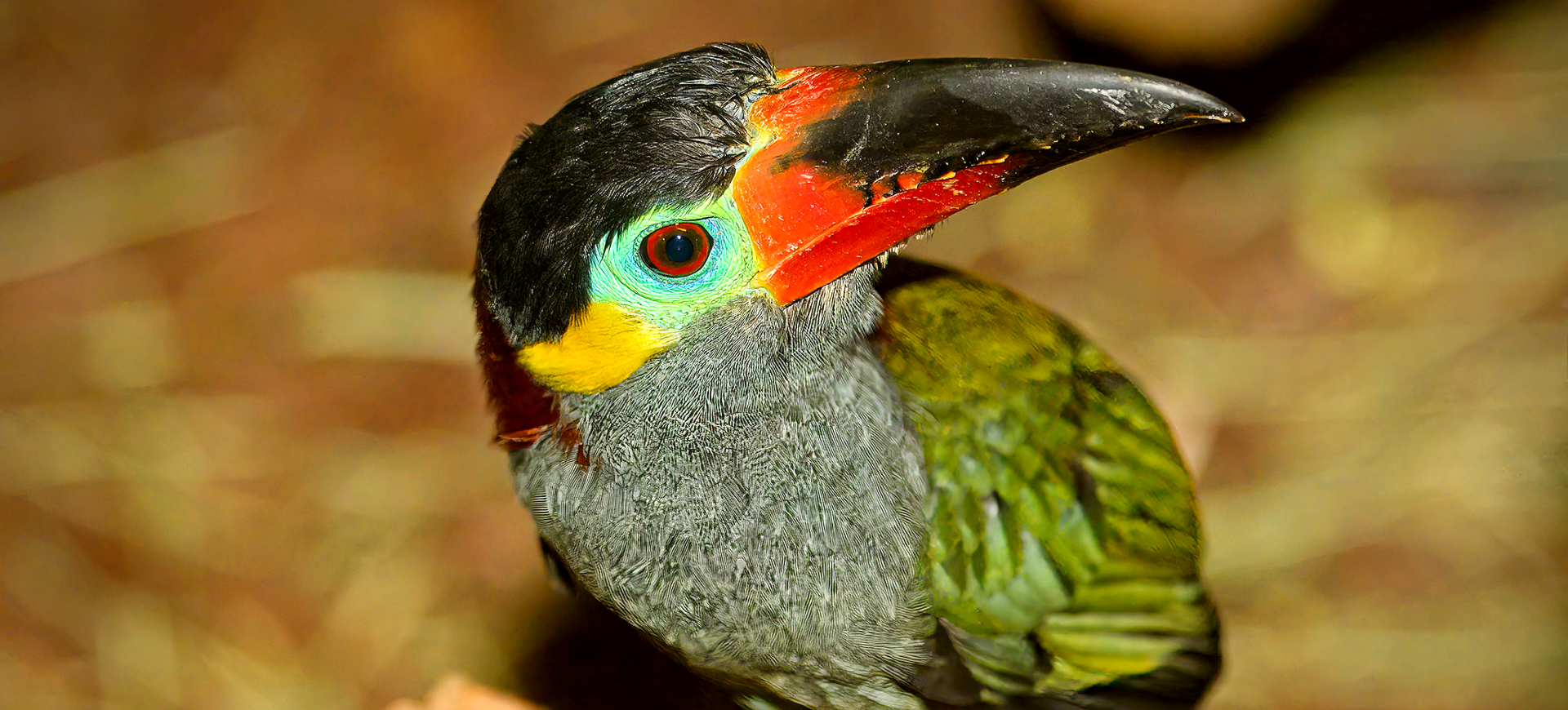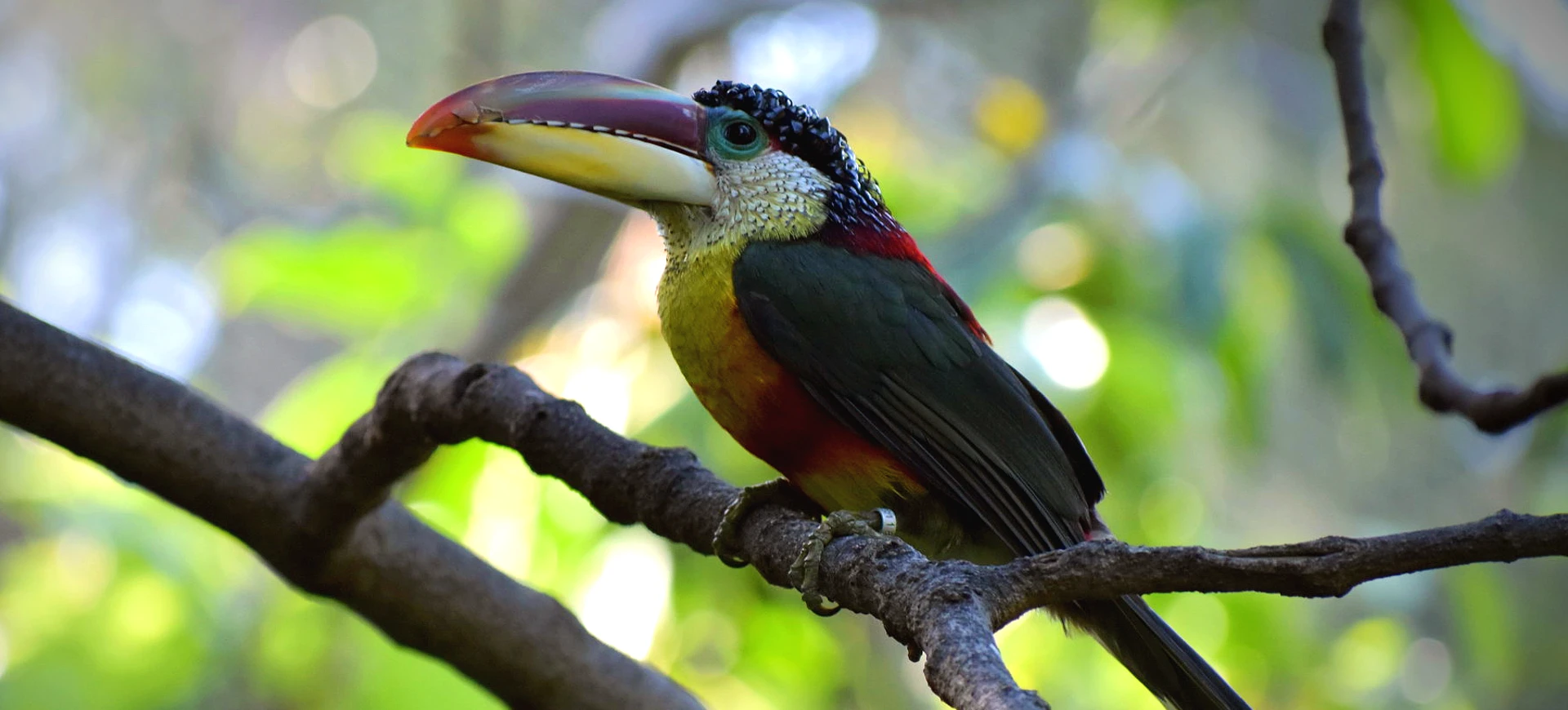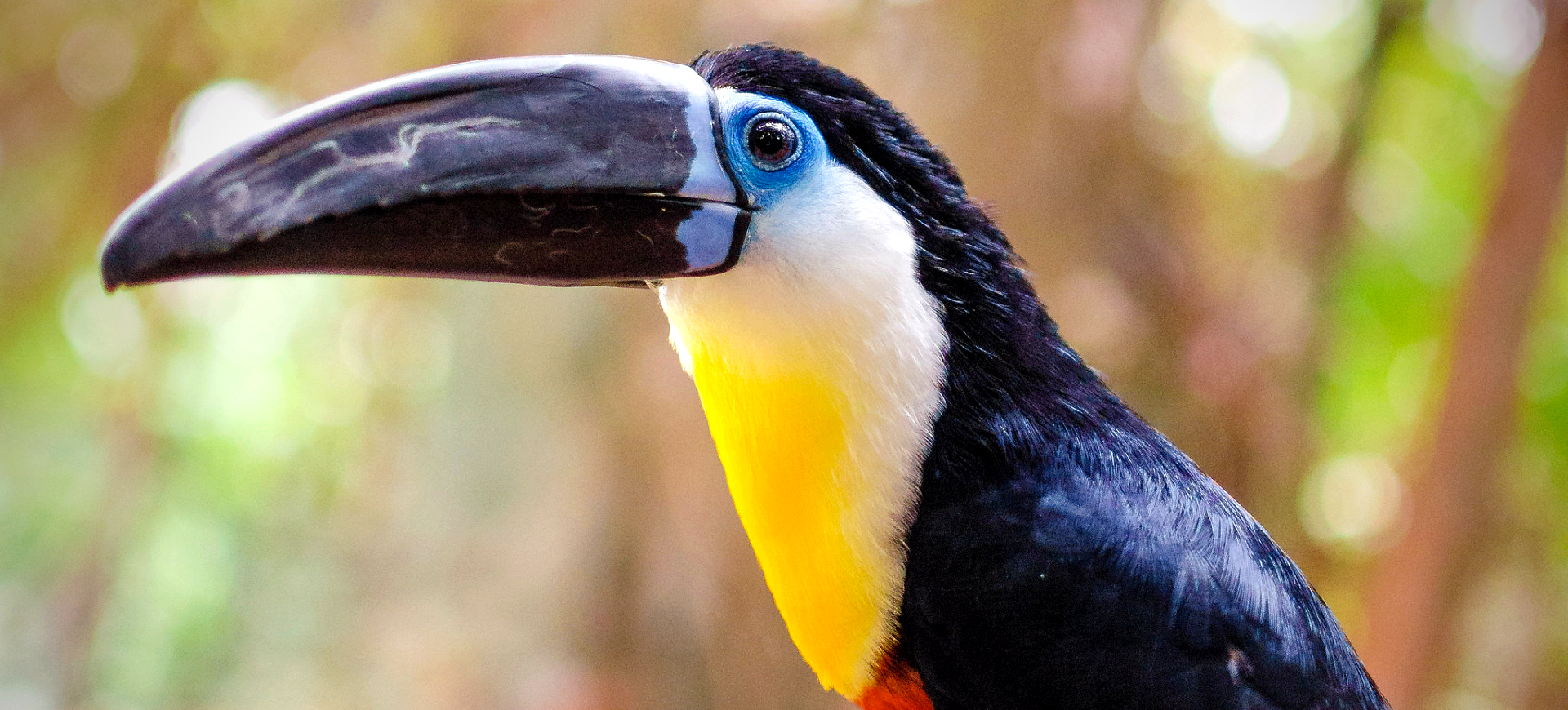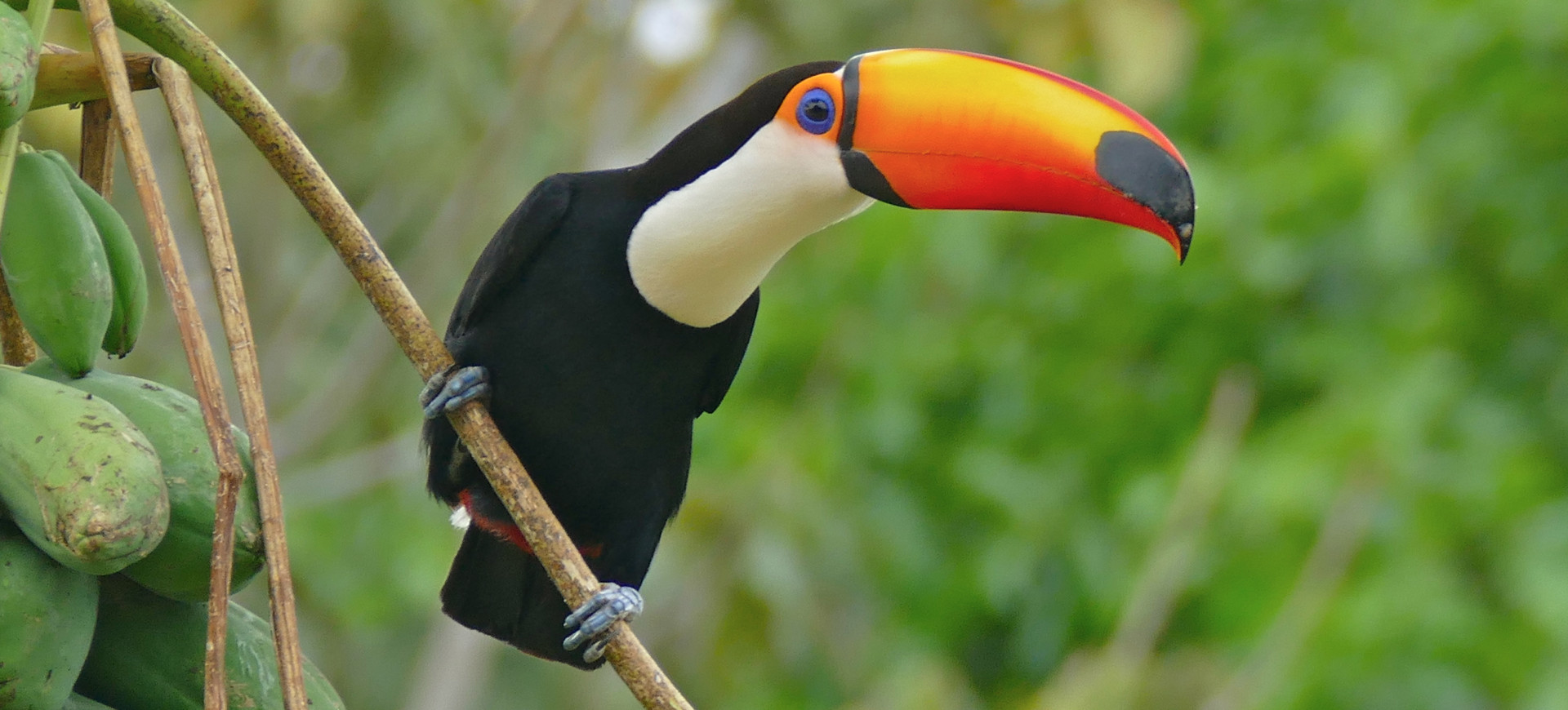Overview
The Red-billed Toucan, a symbol of the tropical forests, is distinguished by its vibrant plumage and large, colorful bill, predominantly red with black markings. This bird is native to South America’s rainforests, thriving in various habitats from lowland rainforests to mountainous regions, demonstrating adaptability to varying environmental conditions. Red-billed Toucans are social birds, often found in small flocks that communicate through loud calls and vocalizations. Thanks to their fruit-dominated diet, these toucans play a crucial role in their ecosystem, acting as seed dispersers for many tree species.
Despite their bright appearance and popularity in the animal kingdom, Red-billed Toucans face threats from habitat destruction and the illegal pet trade. Their distinctive bills are not just for show; they serve multiple functions, including feeding, thermoregulation, and as a means of attracting mates. Red-billed Toucans are cavity nesters, utilizing holes in trees for breeding, emphasizing the importance of preserving mature forests for survival. Conservation efforts for the Red-billed Toucan focus on habitat protection, rehabilitation, and legal measures to combat wildlife trafficking.
The diet of the Red-billed Toucan is predominantly frugivorous, consisting mainly of a variety of tropical fruits, which they skillfully pluck with their long bills. They also consume insects, small birds, and eggs, showcasing opportunistic feeding behavior. This varied diet helps maintain the balance in their ecosystem by controlling insect populations and dispersing seeds. The feeding habits of the Red-billed Toucan highlight their role in pollinating and regenerating tropical forests, contributing to the biodiversity of their habitats.
Taxonomy
Kingdom
Phylum
Class
Order
Family
Genus
Species
Sub Species
Type
Physical Description:
The Red-billed Toucan is instantly recognizable by its large, curved bill, bright red with black markings and can grow up to half the bird’s body length. The bird’s plumage is primarily black with a white throat and chest, and the skin around the eyes is vibrant blue, adding to their striking appearance. They have strong, short legs and zygodactyl feet, with two toes facing forward and two backward, which aids in gripping branches. Adult Red-billed Toucans typically reach a length of 55 to 65 cm (22 to 26 inches), including their bill, making them one of the larger species within the toucan family.
Despite its size, their bill is surprisingly lightweight due to its hollow structure, allowing for easy maneuvering through the canopy. The bright colors of the Red-billed Toucan play a crucial role in social interactions and mate selection, with the bill being a key feature in their displays. The contrasting colors of their plumage provide camouflage in the dappled light of their forest habitat, protecting them from predators. The physical adaptations of the Red-billed Toucan, including its bill and feet, showcase the bird’s evolution for life in the dense tropical forests.

Lifespan: Wild: ~20 years || Captivity: ~25 years

Weight: Male & Female: 0.88-1.87 lbs (400-850 g)

Length: Male & Female: 22-26 inches (55-65 cm) including the bill

Wingspan: Male & Female: 23-28 inches (58-71 cm) including the bill
Characteristic:
Native Habitat:
The Red-billed Toucan (Ramphastos tucanus tucanus) inhabits the dense rainforests of South America, spanning a range from Venezuela and the Guianas to northern Brazil. They prefer high-canopy forests, which reside in the emergent layer, utilizing the dense foliage and abundant fruit trees. These toucans are also found in secondary forests and plantations, demonstrating their adaptability to various degrees of forest alteration. However, they rely on the existence of large, mature trees for nesting, which makes them vulnerable to extensive deforestation and logging.
Preserving their natural habitats is critical for their survival, emphasizing the need for sustainable forestry practices and the establishment of protected areas. The Red-billed Toucan’s preference for diverse, fruit-rich forests underscores the importance of conserving large tracts of contiguous forest. Efforts to mitigate habitat fragmentation and maintain connectivity between forest patches are essential for maintaining toucan populations. Through habitat conservation and management, the Red-billed Toucan can continue to thrive and fulfill its role in tropical forest ecosystems.
Climate Zones:
Biomes:
WWF Biomes:
Biogeographical Realms:
Continents:
Diet:
Diet & Feeding Habits:
The Red-billed Toucan’s diet primarily consists of a wide variety of tropical fruits they gather from the treetops with their long bills. This frugivorous diet is supplemented by insects, small birds, eggs, and occasionally small reptiles, indicating their opportunistic feeding habits. Their ability to reach fruit at the ends of branches, inaccessible to other birds, plays a significant role in their forest ecosystems as key seed dispersers. Red-billed Toucans often participate in mutualistic relationships with fruit-bearing trees, as the trees rely on the toucans to spread their seeds through defecation.
Their feeding behavior contributes to the health and spread of their rainforest habitats, promoting forest regeneration and biodiversity. Red-billed Toucans have a unique way of eating; they toss their food into the air and catch it in their bills before swallowing. They require large areas of intact forest to provide sufficient food resources, highlighting the impact of deforestation on their dietary needs. Conservation efforts aim to preserve the natural habitats of the Red-billed Toucan to ensure they have access to their varied diet and continue their role as seed dispersers.
Mating Behavior:
Mating Description:
Red-billed Toucans are known to form monogamous pairs, with both males and females participating in the nesting process. They utilize natural cavities in trees for nesting, where the female lays 2 to 4 eggs. Both parents share the responsibility of incubating the eggs and feeding the chicks, demonstrating high parental care. The chicks are born altricial (helpless) and depend on their parents for warmth, protection, and food until they are ready to flee.
The breeding season of Red-billed Toucans varies geographically, typically coinciding with the rainy season when food resources are abundant. This timing ensures that there is ample food available for the growing chicks. Nesting sites are critical for the reproductive success of Red-billed Toucans, making the conservation of mature forests with suitable nesting trees a priority. Understanding and protecting the reproductive habits of Red-billed Toucans are essential for their conservation, ensuring the continuation of their populations.
Reproduction Season:
Birth Type:
Pregnancy Duration:
Female Name:
Male Name:
Baby Name:
Social Structure Description:
Red-billed Toucans are social birds, often observed in pairs or small flocks that engage in communal feeding and playful interactions. Their vocalizations are crucial in communication within the flock, maintaining social bonds and coordinating activities. The formation of flocks protects them from predators and enhances their ability to locate food sources. Protecting the environments that support the social life of Red-billed Toucans is crucial for their well-being and conservation.
Understanding the social behavior of Red-billed Toucans is important for conservation planning, particularly in managing their habitats to support flocking and feeding activities. Efforts to preserve natural feeding sites and ensure the availability of flowering plants contribute to the health of toucan populations. The social nature of these birds highlights the importance of maintaining healthy, connected habitats that allow for the natural behaviors and interactions of Red-billed Toucans. Through habitat conservation and the protection of social structures, it is possible to support the thriving populations of these colorful and engaging birds.
Groups:
Conservation Status:
Population Trend:
The Red-billed Toucan is classified as the Least Concern by the IUCN thanks to its extensive range and presence in several protected areas. However, localized threats such as deforestation, illegal pet trade, and habitat fragmentation are causing population declines in some areas. Conservation efforts are focused on habitat preservation, legal protection, and public education to mitigate these threats. Establishing protected areas and habitat restoration projects are crucial for the survival of Red-billed Toucans in the wild.
Monitoring Red-billed Toucan populations helps assess the impact of conservation measures and inform future strategies. Sustainable land-use practices and community involvement in conservation are key to protecting the habitats of Red-billed Toucans. The species’ role as seed dispersers and their contribution to forest diversity highlights the importance of their conservation. Through continued efforts to protect their natural habitats, there is hope for maintaining stable populations of Red-billed Toucans and ensuring the health of tropical forest ecosystems.
Population Threats:
The primary threats to Red-billed Toucans include deforestation for agriculture, logging, and urban development, resulting in their natural habitat loss. The illegal pet trade also impacts populations, with individuals captured for their striking appearance. Climate change may further impact their habitat, altering the distribution of food sources and suitable living conditions. Conservation efforts are focused on addressing these threats through habitat preservation, law enforcement, and public education.
Efforts to mitigate habitat destruction and the impacts of climate change are crucial for protecting the toucans and their ecosystems. To reintroduce them into protected habitats, rehabilitation and rescue centers play a role in caring for toucans affected by habitat loss or the pet trade. International cooperation and enforcing wildlife trade regulations are also important for reducing the demand for illegal pets. Through concerted conservation actions, we can combat the threats facing Red-billed Toucans and support their populations in the wild.
Conservation Efforts:
Conservation initiatives for the Red-billed Toucan include habitat protection, research, and rehabilitation programs. Protected areas and wildlife reserves provide crucial sanctuaries for these toucans, safeguarding their living spaces from deforestation and human encroachment. Research into their ecology, behavior, and population dynamics is essential for developing effective conservation strategies. Rehabilitation centers offer care for toucans injured or displaced by habitat destruction, with many focusing on reintroduction into protected habitats.
Community engagement and environmental education programs raise awareness of the importance of toucans and the need for conservation. Promoting sustainable land use and forestry practices helps preserve the toucans’ natural habitats. International collaboration on wildlife protection policies aids in combating the illegal pet trade. Through these and other conservation actions, we can ensure the continued survival of the Red-billed Toucan and the health of tropical forest ecosystems.
Additional Resources:
Fun Facts
- Red-billed Toucans can regulate their body temperature by adjusting the blood flow to their large bill.
- Despite their large bills, toucans are very precise in handling food, using the tip of their bill to peel fruit and extract seeds.
- Toucans are known for their playful nature, often engaging in games of catch with fruit or objects, tossing them to one another.
- The structure of a toucan’s bill is surprisingly strong yet lightweight, thanks to a network of tiny, air-filled bone cells.
- Toucans sleep with their bill tucked under their wing and their tail folded over their head for warmth and camouflage.
- Their vibrant bill colors may play a role in attracting mates and deterring predators by signaling the bird’s health and fitness.
- Toucans have zygodactyl feet, with two toes facing forward and two backward, which helps them grasp branches and perch securely.
- They are important seed dispersers, eating fruit from one area and defecating the seeds in another, aiding in forest regeneration.
- Red-billed Toucans have a wide vocal range, from croaks and rattles to high-pitched calls, which they use to communicate across the forest canopy.
- Conservation efforts for Red-billed Toucans also benefit other species that share their habitat, highlighting the interconnectedness of tropical forest ecosystems.





